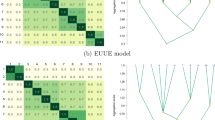Abstract
A method for efficiently calculating exact marginal, conditional and joint distributions for change points defined by general finite state Hidden Markov Models is proposed. The distributions are not subject to any approximation or sampling error once parameters of the model have been estimated. It is shown that, in contrast to sampling methods, very little computation is needed. The method provides probabilities associated with change points within an interval, as well as at specific points.
Similar content being viewed by others
References
Albert, J.H., Chib, S.: Bayes inference via Gibbs sampling of autoregressive time series subject to Markov mean and variance shifts. J. Bus. Econ. Stat. 11, 1–15 (1993)
Aston, J.A.D., Martin, D.E.K.: Distributions associated with general runs and patterns in hidden Markov models. Ann. Appl. Stat. 1, 585–611 (2007)
Balakrishnan, N., Koutras, M.: Runs and Scans with Applications. Wiley, New York (2002)
Barry, D., Hartigan, J.A.: Product partition models for change point problems. Ann. Stat. 20, 260–279 (1992)
Barry, D., Hartigan, J.A.: A Bayesian analysis for change-point problems. J. Am. Stat. Assoc. 88, 309–319 (1993)
Billio, M., Monfort, A.: Switching state space models: likelihood functions, filtering and smoothing. J. Stat. Plan. Inference 68, 65–103 (1998)
Cappé, O., Moulines, E., Rydén, T.: Inference in Hidden Markov Models. Springer, Berlin (2005)
Carpenter, J., Clifford, P., Fearnhead, P.: An improved particle filter for non-linear problems. IEE Proc. Radar Sonar Navig. 146, 2–7 (1999)
Chib, S.: Estimation and comparison of multiple change-point models. J. Econom. 86, 221–241 (1998)
Durbin, R., Eddy, S., Krogh, A., Mitchison, G.: Biological Sequence Analysis. Cambridge University Press, Cambridge (1998)
Eddy, S.R.: What is a hidden Markov model? Nat. Biotechnol. 22, 1315–1316 (2004)
Fearnhead, P.: Exact and efficient Bayesian inference for multiple changepoint problems. Stat. Comput. 16, 203–213 (2006)
Fearnhead, P., Liu, Z.: Online inference for multiple changepoint problems. J. R. Stat. Soc., Ser. B 69, 589–605 (2007)
Feller, W.: An Introduction to Probability Theory and Its Applications, vol. 1. Wiley, New York (1968)
Frühwirth-Schnatter, S.: Finite Mixture and Markov Switching Models. Springer, Berlin (2006)
Fu, J.C., Koutras, M.V.: Distribution theory of runs: a Markov chain approach. J. Am. Stat. Assoc. 89, 1050–1058 (1994)
Guédon, Y.: Exploring the state sequence space for hidden Markov and semi-Markov chains. Comput. Stat. Data Anal. 51, 2379–2409 (2007)
Guédon, Y.: Exploring the segmentation space for the assessment of multiple change-point models. Technical Report 6619, INRIA (2008)
Hamilton, J.D.: A new approach to the economic analysis of nonstationary time series and the business cycle. Econometrica 57, 357–384 (1989)
Juang, B.H., Rabiner, L.R.: Hidden Markov models for speech recognition. Technometrics 33, 251–272 (1991)
Kim, C.-J.: Dynamic linear models with Markov-switching. J. Econom. 60, 1–22 (1994)
Kschischang, F.R., Frey, B.J., Loeliger, H.-A.: Factor graphs and the sum-product algorithm. IEEE Trans. Inf. Theory 47, 498–519 (2001)
MacDonald, I.L., Zucchini, W.: Hidden Markov and Other Models for Discrete-valued Time Series. Chapman & Hall, London (1997)
Martin, A.D., Quinn, K.M., Park, J.H.: MCMCpack: Markov chain Monte Carlo in R. J. Stat. Softw. 42(9), 1–22 (2011)
R Development Core Team: R: A Language and Environment for Statistical Computing. R Foundation for Statistical Computing, Vienna (2011). ISBN 3-900051-07-0
Rabiner, L.R.: A tutorial on hidden Markov models and selected applications in speech recognition. Proc. IEEE 77, 257–286 (1989)
Sims, C.A., Zha, T.: Were there regime switches in US monetary policy? Am. Econ. Rev. 96, 54–81 (2006)
Viterbi, A.: Error bounds for convolution codes and an asymptotically optimal decoding algorithm. IEEE Trans. Inf. Theory 13, 260–269 (1967)
Author information
Authors and Affiliations
Corresponding author
Electronic Supplementary Material
Below is the link to the electronic supplementary material.
Rights and permissions
About this article
Cite this article
Aston, J.A.D., Peng, J.Y. & Martin, D.E.K. Implied distributions in multiple change point problems. Stat Comput 22, 981–993 (2012). https://doi.org/10.1007/s11222-011-9268-6
Received:
Accepted:
Published:
Issue Date:
DOI: https://doi.org/10.1007/s11222-011-9268-6




